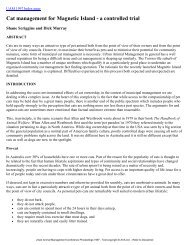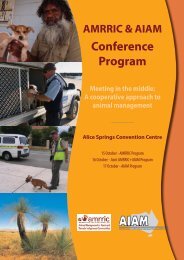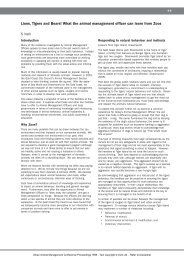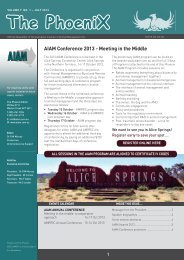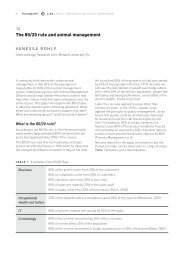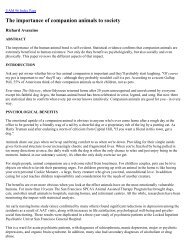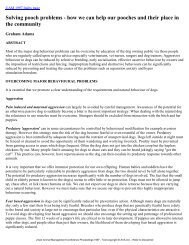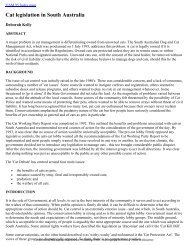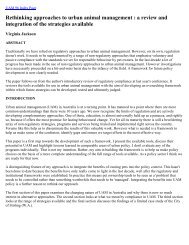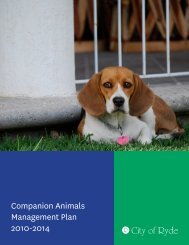Proceedings OF ThE - Australian Institute of Animal Management Inc
Proceedings OF ThE - Australian Institute of Animal Management Inc
Proceedings OF ThE - Australian Institute of Animal Management Inc
Create successful ePaper yourself
Turn your PDF publications into a flip-book with our unique Google optimized e-Paper software.
50 <strong>Proceedings</strong> 2012<br />
AIAM Annual Conference on <strong>Animal</strong> <strong>Management</strong><br />
Commonly shared issues<br />
– remote and urban<br />
In remote communities common problems relate<br />
to animal welfare and public nuisance. They include<br />
overpopulation from uncontrolled dog breeding;<br />
visibly diseased, malnourished animals (mainly dogs);<br />
public health considerations related to external and<br />
internal parasites; noise and nuisance from fighting<br />
and pack behaviour; spreading <strong>of</strong> rubbish while<br />
scavenging for food and public safety concerns with<br />
dog bite injuries from aggressive animals (Donelan<br />
2006). Unrestrained breeding <strong>of</strong> larger breed e.g. pig<br />
dogs negatively influences the makeup <strong>of</strong> the next<br />
generation <strong>of</strong> pups in many top end communities<br />
(AMRRIC 2007).<br />
Many people are <strong>of</strong>ten overwhelmed by free<br />
breeding dogs and cats and have little access to<br />
desexing programs and population control. They feel<br />
disempowered by non-Aboriginal decision makers<br />
and struggle to access resources such as normal<br />
veterinary services, medications, information or<br />
education to improve the situation resulting in the<br />
overall poor state <strong>of</strong> animal health and welfare.<br />
It is positive to note some change in recent years<br />
regarding these services.<br />
Aboriginal people commonly share their concerns<br />
that health status <strong>of</strong> their dogs (in particular) impact<br />
on human health and welfare. Zoonotic diseases<br />
and mental health and wellbeing concerns such as<br />
embarrassment or ‘shame’ about the state <strong>of</strong> their<br />
companion animals’ health are <strong>of</strong>ten heard. They<br />
express fear <strong>of</strong> attacks from free roaming dogs to<br />
themselves and other dogs.<br />
Although there are a wide variety <strong>of</strong> situations,<br />
AMRRIC after many years <strong>of</strong> working with Aboriginal<br />
and Torres Strait Islander communities across<br />
Australia observe similar problems across the<br />
country. It appears that longstanding animal health<br />
and welfare management issues exist in many <strong>of</strong><br />
those communities with varying degrees <strong>of</strong> veterinary<br />
programs, resources, education or pr<strong>of</strong>essional<br />
support to address the situation. Whilst some<br />
communities seem to be way ahead in terms <strong>of</strong><br />
achieving locally owned and driven success in this<br />
area, we have seen few models <strong>of</strong> truly sustainable<br />
change. AMRRIC is currently attempting to build a<br />
sustainable model in the NT that is being rolled out in<br />
partnership with three shires.<br />
Developing trustful relationships is the key<br />
“Some <strong>of</strong> the greatest challenges in providing<br />
veterinary services to remote communities centre<br />
on lack <strong>of</strong> understanding and trust. Education and<br />
developing a trusting relationship with community<br />
members is the key to success, but <strong>of</strong>ten there are<br />
barriers, [including] language and cultural’, (Kennedy<br />
cited in Constable and Lucia 2011) especially when<br />
local people aren’t involved. The lack <strong>of</strong> trust can<br />
mostly be attributed to a history <strong>of</strong> <strong>of</strong>ten brutal<br />
forms <strong>of</strong> companion animal management with<br />
routine poisoning, shooting forming the mainstay<br />
<strong>of</strong> companion animal control. In more recent<br />
times lack <strong>of</strong> trust is deepened or reinforced when<br />
unknown contractors are bought in to communities<br />
by non-Aboriginal authorities to undertake mass<br />
non- consensual euthanasia programs as a reactive<br />
response to the death or mauling <strong>of</strong> someone.<br />
The Veterinarian, the <strong>Animal</strong> Control Officer or<br />
Rangers are <strong>of</strong>ten the frontline people involved in<br />
delivering a dog health and welfare strategy in an<br />
Aboriginal community. They are <strong>of</strong>ten faced with a<br />
culturally complex environment and a background <strong>of</strong><br />
fraught cross-cultural interaction. Many Aboriginal<br />
and Torres Strait Traditional Owners or Dog Dreaming<br />
Elders possess authority or custodianship over<br />
dog matters within existing systems <strong>of</strong> traditional<br />
governance. For lasting and beneficial companion<br />
animal control change to occur it is essential that<br />
those with authority to speak contribute to planning<br />
a control program. Identifying those key people and<br />
‘working with them rather than for them’ (Phelan 2006)<br />
is vital.<br />
Programs require significant planning with local<br />
staff, traditional owner groups and key stakeholders<br />
that support animal control and regulation. A QLD<br />
Health Environmental Health Worker stated recently<br />
‘It is important for agencies and other people<br />
who visit these communities to understand the<br />
environment these services are provided in and the<br />
experience required to provide animal management<br />
services in discreet communities’. Programs are<br />
best approached in this way, and ideally with a locally<br />
employed animal management worker or similar<br />
person, who has the communities trust, speaks the<br />
local language and has the relationships.<br />
Unless people have a trustful relationship with<br />
the veterinarian or the animal management staff<br />
in a community they are not likely to engage in the<br />
program, pick up the phone or ask for assistance.<br />
This can also be an issue in urban areas where people<br />
may be or feel economically or socially excluded, e.g.<br />
when people are ‘shame jobbed’ or embarrassed<br />
inadvertently or purposefully about the condition <strong>of</strong><br />
their pets.<br />
Acting with integrity to build respect and trust with<br />
community stakeholders and community engagement<br />
in the program is a must to improving the welfare<br />
<strong>of</strong> animals (Donelan 2006). In a climate <strong>of</strong> mistrust,<br />
resulting from inappropriate culling programs or<br />
treatments and surgical procedures undertaken<br />
without owner permission, nothing can be achieved.<br />
Everything we do relies on the process <strong>of</strong> relationship<br />
building and respect.



